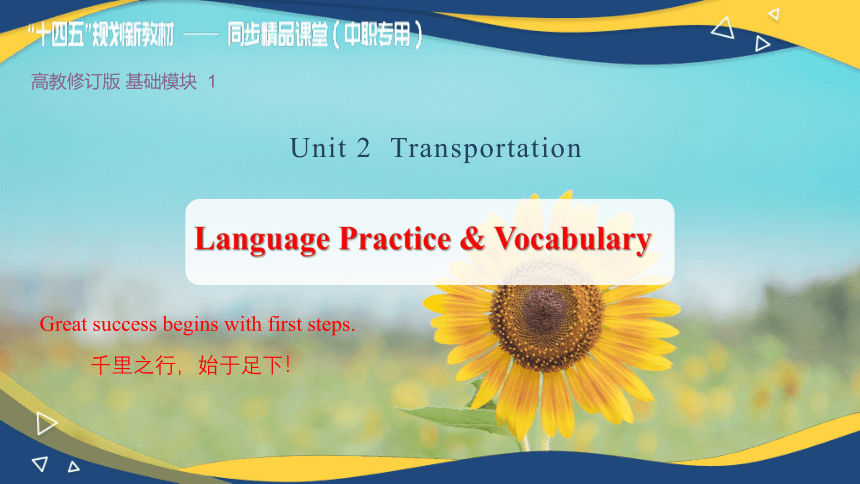(
课件网) Unit 2 Transportation Great success begins with first steps. 千里之行,始于足下! Language Practice & Vocabulary 高教修订版 基础模块 1 Learning objectives knowledge objectives ability objectives emotional objectives Master the basic usage of the present tense, and can accurately use the present tense. develop good study habits, improve pragmatic ability. Understand the diversity of culture, understand the differences in thinking. 祈使句 vocabulary exercise 1. 2. Contents 3. 4. Homework 祈使句 Part 1 Imperative sentence review 读句子,注意动词 Don’t worry about it. Take Line 6. Change for Subway Line 2 at Zhuquemen station. Get off at Zhonghua Square station. Take Exit B. 祈使句:用于表达命令、请求、劝告、警告、禁止等的句子。 祈使句 学习使用祈使句的肯定、否定形式表达规则 祈使句 定义 祈使句是表示命令、请求、建议、禁止等的句子。 默认主语是you,通常省略。 祈使句的动词都为一般现在时。 根据句子语气的强弱,句末用感叹号或句号。 1.Do 型 : 以行为动词原形开头,简称Do型。 eg:Listen to me, please.请听我说。 2.Be 型: 以动词be开头,简称Be型。 eg:Be quiet, please. 请安静。 3.Let 型: 以Let开头,简称Let型。 eg. Let’s go to school. 让我们去学校。 一、祈使句的肯定式 祈使句 注意: 有时可在祈使句的句首或句尾加上please,使语气显得客气、有礼貌。 如果在句尾加please,应该用逗号与前句隔开。 e.g. Go this way, please. 请这边走 祈使句 二、祈使句的否定式 1. Do型和Be型的否定式是在句首加don’t。 e.g. Don’t sit here. 不要坐在这儿。 Don’t be late. 别迟到。 2. 以let开头的祈使句,其否定式有两种: 1)直接在句首加don’t, 2)“let + 宾语 + not +动词原形+ (其他)”。 e.g. Don’t let him go. 不要让他走。 Let’s not go there. 咱们别去那儿。 一般现在时 一般现在时 祈使句 注意: “No+名词/动词 ing形式”表示禁止或规劝,常用于公共场所。 e.g. No photos! 禁止拍照! No smoking! 禁止吸烟! 肯定祈使句 否定祈使句 Sit down. Come in. Eat at home. Listen to music outside. Don’t sit down. Don’t come in . Don’t eat at home. Don’t listen to music outside. 祈使句 将下列句子翻译成英语。 1. 请看这幅图画。 2. 不要在教室里跑。 3. 让我们帮助他。 4. 在图书馆保持安静。 5. 上课不要迟到。 Please look at the picture. / Look at the picture, please. Don’t run in the classroom. Let’s help him. 祈使句练习 Be quiet in the library. Don’t be late for class. 看以下标志,将其与对应的指令相匹配。 Look and match. _____ 1) Be careful with the wet floor. _____ 2) Please don’t knock on the door. _____ 3) Wash your hands properly. _____ 4) Do not enter. A B C D C D B A 祈使句练习 properly 恰当地,正确地 enter 进入 读以下句子,将逻辑和含义对应的前后句相匹配。 Read and complete. A. Please switch your phone to flight mode. B. Please tell me the way. C. Take your raincoat. D. Watch out! E. Don’t be late for the train at 10:10 am. F. Let’s use the shared bikes. 1) It is already 10 o’clock. ( ) 2) The floor is wet. ( ) 3) I need to go to the post office. ( ) 4) It’s rush hour now. ( ) 5) We are taking off soon. ( ) 6) It is raining. ( ... ...

